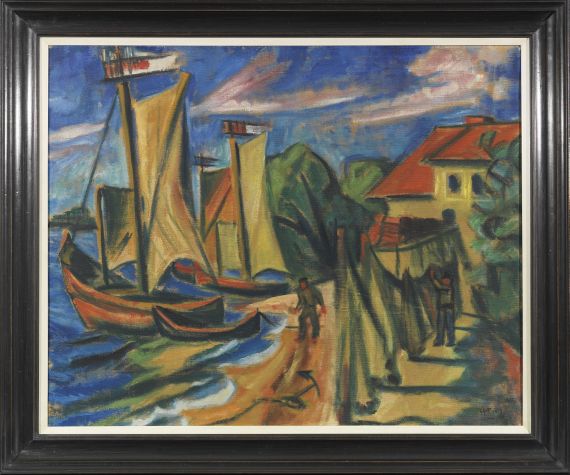230
Hermann Max Pechstein
Sommermorgen, 1919.
Oil on canvas
Estimate:
€ 250,000 / $ 282,500 Sold:
€ 350,000 / $ 395,499 (incl. surcharge)
Sommermorgen. 1919.
Oil on canvas.
Soika 1919/44. Lower right monogrammed (in ligature) and dated as well as titled on verso. Inscribed by a hand other than that of the artist on the stretcher. 81 x 100 cm (31.8 x 39.3 in), (Soika mentions dimensions of ca. 74 x 79 cm due to different information supplied by the owner to the Max Pechstein-UHRG in 1970).
Brilliant expressive Nida landscape from the days of an artistic renaissance in 1919 after the end of World War I. The work delivers impressive proof of Pechsteins lasting love with the small coastal town Nida, which Pechstein always described as his "painters paradise" (quote after Soika, Max Pechstein, 2011, p. 31).
A coastal landscape with boathouse and male figures in similar coloring from 1919 is in the collection of the Brücke Museum in Berlin (cf. Soika 1919/73).
PROVENANCE: Galerie Gurlitt, Berlin (until 1923; on consignment).
Galerie Alfred Flechtheim, Düsseldorf/Berlin (with fragments of a label on the stretcher, there with inscription "3896/Pechtein Hafen II").
Fritz and Irma Epstein, Duisburg/Los Angeles (acquired from Galerie Alfred Flechtheim in the 1920s).
Gerhard and Marianne Epstein Pinkus, Los Angeles (inherited from aforementioned).
Private collection USA (obtained from aforementioned).
LITERATURE: Hubertus Froning, Küstenbilder, Ramerding 1985, with illu. on p. 62.
Oil on canvas.
Soika 1919/44. Lower right monogrammed (in ligature) and dated as well as titled on verso. Inscribed by a hand other than that of the artist on the stretcher. 81 x 100 cm (31.8 x 39.3 in), (Soika mentions dimensions of ca. 74 x 79 cm due to different information supplied by the owner to the Max Pechstein-UHRG in 1970).
Brilliant expressive Nida landscape from the days of an artistic renaissance in 1919 after the end of World War I. The work delivers impressive proof of Pechsteins lasting love with the small coastal town Nida, which Pechstein always described as his "painters paradise" (quote after Soika, Max Pechstein, 2011, p. 31).
A coastal landscape with boathouse and male figures in similar coloring from 1919 is in the collection of the Brücke Museum in Berlin (cf. Soika 1919/73).
PROVENANCE: Galerie Gurlitt, Berlin (until 1923; on consignment).
Galerie Alfred Flechtheim, Düsseldorf/Berlin (with fragments of a label on the stretcher, there with inscription "3896/Pechtein Hafen II").
Fritz and Irma Epstein, Duisburg/Los Angeles (acquired from Galerie Alfred Flechtheim in the 1920s).
Gerhard and Marianne Epstein Pinkus, Los Angeles (inherited from aforementioned).
Private collection USA (obtained from aforementioned).
LITERATURE: Hubertus Froning, Küstenbilder, Ramerding 1985, with illu. on p. 62.
After the end of World War I Max Pechstein felt attracted by the small town of Nida on the Curonian Spit at the Baltic Sea, today part of Lithuania. He leads a simple and free life in an almost pristine nature, going sailing and fishing with the local fishermen. The village helps Pechstein to a mental and artistic renaissance after the experience of the cruelties of the war. In 1909 he visited the remote fishing village, which had already gained popularity among artist,s for the first time. In the 1870s Lovis Corinth made Nida his home during the summer months and followed a trend that began in the 19th century when many artists sought countryside seclusion. This tradition found a new peak during Expressionism. Pechstein‘s artist colleagues Otto Mueller and Max Beckmann were intensively occupied with the unity of man and nature. First and foremost, the painters felt attracted by the light‘s unusual intensity and the almost surreal colors of this haven. Pechstein's motivation to flee the big citiy was a certain romantic longing; the urge to merge art and nature. Nida is nestled between sand dunes, forests, the Baltic Sea and the lagoon. Fascinated by the landscape‘s nativeness, he visited the place regularly up into the 1930s. Pechstein wrote: “Nida is a joy, the sun setting in the Baltic and rising from the lagoon, wonderful pine trees and dunes all along the shore [..]“, it is a “rich treasure grove for the painter to see the flounder fishermen landing and all the people moving about between the small black and blue boats, the sand – depending on the time of the day – yellow or rose and the sea green or deep blue with white wave crests [..]“. (Quote Hermann Max Pechstein, in: Timm, Werner (editor): Ostsee-Bilder. Gemälde, Zeichnungen, Photographien, Regensburg 1981). [KD]
230
Hermann Max Pechstein
Sommermorgen, 1919.
Oil on canvas
Estimate:
€ 250,000 / $ 282,500 Sold:
€ 350,000 / $ 395,499 (incl. surcharge)
Headquarters
Joseph-Wild-Str. 18
81829 Munich
Phone: +49 89 55 244-0
Fax: +49 89 55 244-177
info@kettererkunst.de
Louisa von Saucken / Undine Schleifer
Holstenwall 5
20355 Hamburg
Phone: +49 40 37 49 61-0
Fax: +49 40 37 49 61-66
infohamburg@kettererkunst.de
Dr. Simone Wiechers / Nane Schlage
Fasanenstr. 70
10719 Berlin
Phone: +49 30 88 67 53-63
Fax: +49 30 88 67 56-43
infoberlin@kettererkunst.de
Cordula Lichtenberg
Gertrudenstraße 24-28
50667 Cologne
Phone: +49 221 510 908-15
infokoeln@kettererkunst.de
Hessen
Rhineland-Palatinate
Miriam Heß
Phone: +49 62 21 58 80-038
Fax: +49 62 21 58 80-595
infoheidelberg@kettererkunst.de
We will inform you in time.




 Lot 230
Lot 230 

